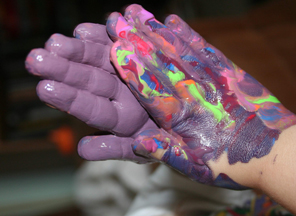 When you paint, please do not repeat what has been done thousands of times. Rather, experiment! You can work on a conventional subject, but in a new way. As a painting instructor, I have never been one to say: “You always start by…, and next, you do…” Where is the creativity in that? The “always” is necessarily modified by the context—in which you paint and in which you cook. I have met many painting instructors who announce “regal” rules as if they were commandments of the Universe. For my part, for this post, they do not apply, unless we are dealing with the scientific physiology of colours… and food. But as for the way you hold a brush and apply paint—your personal way, your personal mythology, the how and the why simply belong to you. After 26 years of teaching, I still receive students who ask how to squeeze paint out of a tube, how to put it on a palette, how to clean paint brushes, how to wipe their hands, and so forth. These questions are manifestations of their own fear. My answer? Just do it! Experiment and you will see; you will find your truth. The students then learned how to take the bull by the horns, which was a significant step forward. Both small steps and leaps of faith are needed in both painting and cooking. Believe in what you paint, act on your belief and you will have a good painting. Believe in what you cook, act on your belief and you will have a good dish. However, a few notions on colour, painting and cooking will help you go ahead with your own creations. And never forget : Verum esse ipsum factum!
When you paint, please do not repeat what has been done thousands of times. Rather, experiment! You can work on a conventional subject, but in a new way. As a painting instructor, I have never been one to say: “You always start by…, and next, you do…” Where is the creativity in that? The “always” is necessarily modified by the context—in which you paint and in which you cook. I have met many painting instructors who announce “regal” rules as if they were commandments of the Universe. For my part, for this post, they do not apply, unless we are dealing with the scientific physiology of colours… and food. But as for the way you hold a brush and apply paint—your personal way, your personal mythology, the how and the why simply belong to you. After 26 years of teaching, I still receive students who ask how to squeeze paint out of a tube, how to put it on a palette, how to clean paint brushes, how to wipe their hands, and so forth. These questions are manifestations of their own fear. My answer? Just do it! Experiment and you will see; you will find your truth. The students then learned how to take the bull by the horns, which was a significant step forward. Both small steps and leaps of faith are needed in both painting and cooking. Believe in what you paint, act on your belief and you will have a good painting. Believe in what you cook, act on your belief and you will have a good dish. However, a few notions on colour, painting and cooking will help you go ahead with your own creations. And never forget : Verum esse ipsum factum!
Veni, vedi, veci ! Conquering the landscape !
Com...


0 Comments